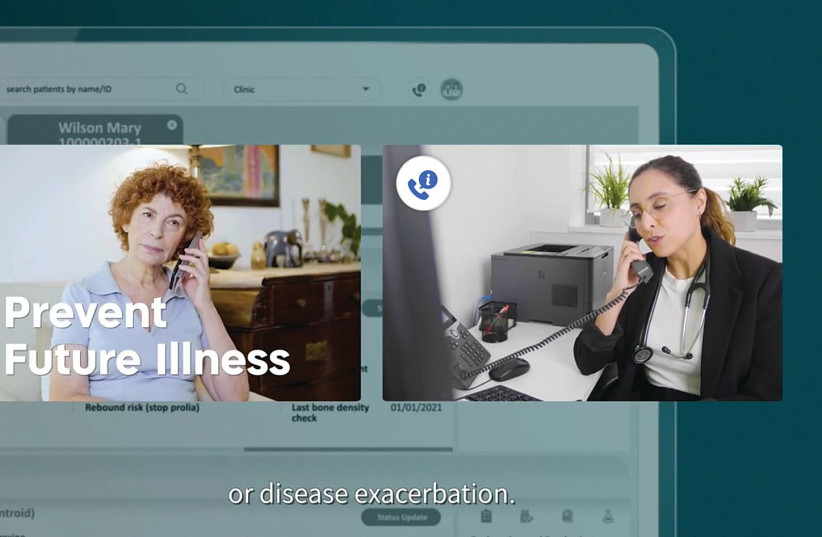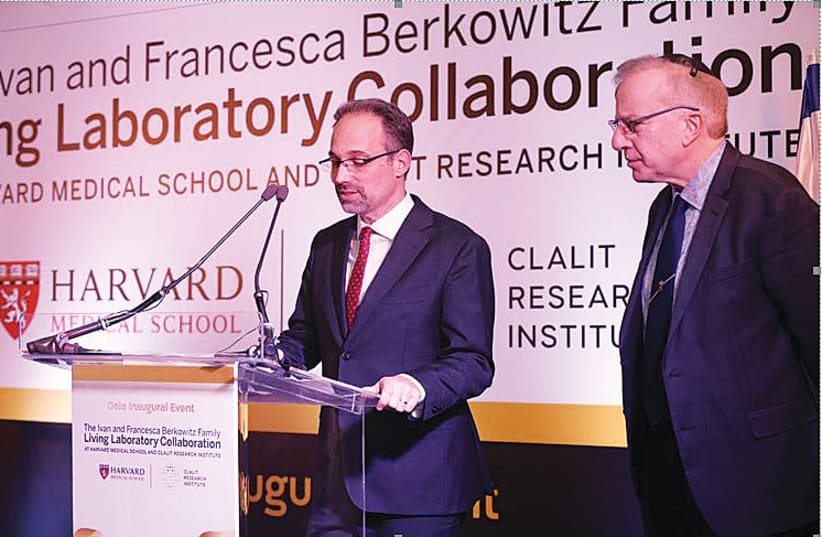Clalit Health Services – the largest of Israel’s four nonprofit public health maintenance organizations (HMOs), which was founded as a mutual aid society in 1911 – is striving once and for all to discard its rather outmoded image that existed until it parted from the Histadrut in 1995.
Then, the National Health Insurance Law separated the health funds from their parent organizations, and Clalit’s owner, the Histadrut labor federation, seemed to be the dustiest of them all.
Until the law that provided universal medical care to all citizens, the other HMOs were not required to accept members because of their age, location or medical or financial status, but what was then called Kupat Holim Clalit had to admit all members of the labor federation.
At the beginning of 1995, 5.2 million people were insured by all four health funds, while at the end of 2014, 8.1 million persons were covered as a right. At the beginning of 1995, Clalit’s market share was approximately 63%, followed by Maccabi at 19% and Meuhedet and Leumit at 9% each. Today, with nearly five million members, Clalit’s share has dropped to slightly over half of all Israelis, compared to a quarter in Maccabi Healthcare Services, 14% in Meuhedet and 9% in Leumit.
But while Clalit’s relative membership has dropped in the last three decades, management is doing its utmost to become the country’s first innovation-driven HMO, making it the most proactive and advanced technologically for the benefit of its patients and its doctors and other medical staffers.

So says Prof. Ran Balicer, Clalit’s deputy director-general and chief innovation officer, who established the Clalit Research Institute in 2010. He earned his medical degree from Tel Aviv University’s Sackler Faculty of Medicine, a master’s of public health degree from Beersheba’s Faculty of Health Sciences at Ben-Gurion University of the Negev and a Ph.D. in health systems management from BGU.
His chief interests include utilizing data science to drive predictive and precise healthcare practice, outcomes research using large clinical datasets, and epidemiology of infectious diseases. In the last three years he served as Israel’s chair of the expert advisory team to the government on the COVID-19 response, during which time he also published some of the world’s most cited timely evidence on vaccine effectiveness and side effects.
"Turning health data into decision-making insights"
In an interview with The Jerusalem Post, Balicer discussed one of Clalit Innovation’s key missions – to “turn health data into decision-making insights that can be translated into tools and policies that transform healthcare delivery and clinical practice.”
A relatively small proportion of Clalit members, who can leave easily on several dates per year by signing forms online or in the post office, have moved to another HMO, he said.
“The vast majority of Clalit members remain for their entire lives, and it is our mission not to just reactively provide them with care when they are already in pain, but rather to proactively keep them healthy. Clalit owns and operates 14 medical centers including almost a third of the country’s acute care beds and over 1,500 primary care community clinics around the country. Its employees include almost 35,000 doctors, nurses, paramedics, technicians, pharmacists and administrators,” he said.
“Our research institute, fully focused on extremely large dataset-based research – was the first of its kind in Israel and is among the few in the world to be recognized as a collaborating center of the World Health Organization. We have a unique advantage over other healthcare systems, because we provide all types of care integrated under one roof, and our data is likewise integrated and decades-deep,” he said.
In the mid-1990s, Clalit set up an integrated electronic health records (EHR) database made up of comprehensive clinical and administrative data with some records dating back to the early 1990s.
“In our research center, we were able to attract unique talent that received global recognition in winning first place in the one and only Data Analysis Challenge to date of the prestigious New England Journal of Medicine [SPRINT Challenge] that took place in 2017. Boston University was second and Stanford University in California was third. Even though we were at the time small and not as well funded compared to Ivy League institutions, our team led by Dr. Noa Dagan was able to create something truly transformational by addressing urgent meaningful needs from the point of view of both the patient and physician.
“We gradually transformed from a research center to an innovation division, from focusing mainly on data science, to translational use of this science for healthcare practice transformation,” Balicer added. “We believed we must create new tools to recommend the best care for our members at any given time, based on our accumulation and analysis of data.”
Because the American medical system, for example, is private and not centralized and citizens are quite leery of the federal government, Israel is way ahead of the US in collecting and using data for translational medicine.
“We were able to establish one of the world’s most advanced systems of physician decision-support with over two decades of anonymous rich data on patients whose identities are kept strictly private and protected,” assured Balicer.
“Artificial intelligence is, in fact, a set of tools, some new and some quite established, but each can be used in clinical practice only if you know exactly what you are able to achieve with adequate precision. Some of the new generative tools like ChatGPT in their current form can be crude and backfire, providing the wrong information, and are therefore not yet integrated in our decision-support systems. If you don’t know how to use your toolset well, you risk going astray. We aim to stay ahead of the curve on the newest methodologies and technology to allow the redesigning of daily healthcare practice for the better.”
The innovation division, which started 13 years ago as a semi-academic research institute, now works from within Clalit in practical ways, to innovate and provide better care for their members. In view of the global shortage of healthcare staff and resources, if an HMO is not focused on innovation, Balicer continued, “it won’t be sustainable.”
Asked how many people work at the institute, he answered that “it’s less than a hundred. But the quality of people, not the quantity, is most important. We have some of the brightest clinicians in the country, whom we train both in public health and in state-of-the-art data science. It’s a full-time job for most of them.”
ONE OF its projects was to create a predictive model for chronic kidney disease; another was to decide who should first be invited in for the flu vaccine – not according to alphabetic order or age but who was at greatest risk for winter severe morbidity due to complication of influenza on top of existing chronic diseases. Another was identifying people with a combination of illnesses that put them at top risk for hospital admissions, providing them with dedicated proactive nurse-physician team support.
“It has reduced admissions to hospitals of people with flu complications by over 40%.”
But its “crown jewel” has been “our systematic – not piecemeal – way of doing it for the last two and a half years using the platform we called C-Pi [Clalit predictive-proactive interventions],” Balicer explained.
It took teams of three Clalit divisions working to couple the machine-learning predictive models of the Clalit Research Institute with clinical pathways charted by key clinician opinion leaders based on the most up-to-date literature. These were integrated by Clalit’s digital division software development teams into a new designated platform within the physician’s electronic health record. The system provides proactive clinician decision support that addresses population-level health issues that impact Clalit members.
Even though it functions in a small country with fewer than 10 million residents, “Clalit is one of largest integrated payer-provider systems in the world, providing primary, hospital and specialty care under one roof, as well as dental services, imaging – and all this data is likewise integrated. Already over 1,000 primary care doctors in the outpatient setting daily receive our AI-driven recommendations. Instead of waiting for patients to come in, the doctor gets a prioritized list of what is most likely to happen to their patients and brings them in proactively, even though they feel fine.”
There are personalized specialist-level recommendations.
“For instance, the system crunches data every night on our 350,000 diabetic patients and sends out to their health records nine million recommendations for improving their treatment based on their individual most updated data. One in 10 older adults have early signs of chronic kidney disease, so our system identifies those patients and suggests adjusting the diabetes treatment to best fit their kidney function. If a certain patient has routine blood tests that show he has a combination of factors that suggest that he unknowingly harbors asymptomatic hepatitis C – which can be cured with drugs – machine-learning algorithms we developed in-house pick it up to prevent him from getting liver function problems and even liver cancer.”
This, says Balicer with pride, “is a new approach – a paradigm shift. Israel is probably one of the only countries in the world that is moving swiftly from reactive healthcare to proactive care. In some countries, it was claimed there is no business case for prevention, but for us it is a no-brainer – they are our members for life, and it is clear that the only sustainable option is to keep them healthy for the long term. This is partly why our system is more patient-centered, and more focused on primary care, where physicians have more time to provide preventive care through conversation with patients.”
Many get online care and don’t have to go to their health fund clinic often – Clalit has had an online pediatrics service for nearly a decade and a half and was the first to offer TYTO, a digital device placed in the ear or mouth or put on the chest to allow telecare looking in the ear and listening to heart and lungs of children and adults.
During the pandemic, the innovation institute was the first institution in Israel, and, apparently, he said, the first in the world – in April 2020 – that proactively used a machine-learning-based predictive model to identify and warn people who were at high risk to be hospitalized with COVID-19 complications.
“We created a national ‘points model’ shown on TV channels and showed how viewers could calculate their own risk of severe complications, and change their behavior accordingly to minimize risk. Through our Berkowitz Family Living Lab collaboration with the Harvard School of Medicine Department of Medical Informatics, we created tools and inferences in near real-time that had an impact on decision-making globally.”
Clalit still has the neediest population among all four health funds, as in 1995, “but we have undergone a substantial revolution in the past decades that accelerated in the past few years from being a part of the Histadrut to being at the global forefront of technology and translational science, aiming to serve as a beacon and a model. It was a miracle to be freed from the shackles of the Histadrut, and we have never looked back,” Balicer concluded.
